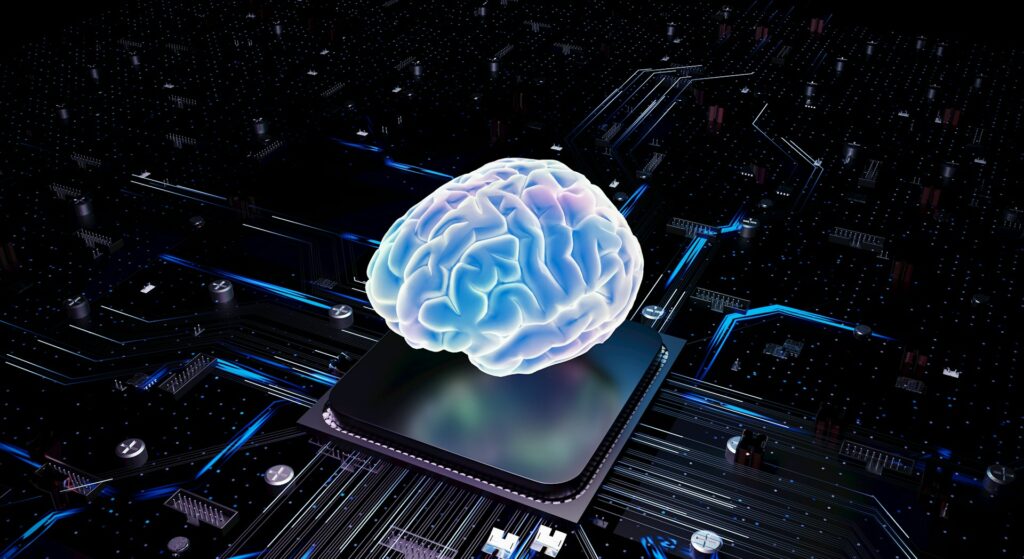Neuromorphic Computing: Emulating the Human Brain

Neuromorphic Computing: Emulating the Human Brain
Although the field of artificial intelligence has made significant strides in recent years, the vast majority of AI systems continue to depend on conventional computer architectures. When compared to the human brain, these designs, despite their capacity, are unable to compete in terms of energy efficiency and flexibility. Neuromorphic computing is a groundbreaking technique that aims to replicate the structure and function of the human brain, and it is currently being developed by researchers in an effort to overcome these constraints.
Neuromorphic computing has the potential to usher in a new age of computers that are more intelligent, more efficient, and quicker than ever before. This is because neuromorphic computing involves duplicating the way that neurons and synapses process and transfer information.
What is neuromorphic computing, and what are some of its applications?
The field of computer engineering known as neuromorphic computing is responsible for the development of both hardware and software that are inspired by the human brain. Neuromorphic systems employ spiking neural networks (SNNs) to transfer signals in a manner that is comparable to that of biological neurons, which is different from the way that conventional computers process information. Conventional computers process information sequentially, whereas neuromorphic systems process information in parallel.
These systems work using a processing method that is driven by events. This means that they only use energy when there is activity taking place, which is similar to how the brain functions. Neuromorphic chips are able to achieve a far higher level of efficiency than regular processors as a result of this.
Neuromorphic systems exhibit a number of characteristics that are considered to be essential.
Processing in Parallel
Similarly to the brain, neuromorphic devices are able to process numerous streams of information at the same time.
Event-driven architecture is a kind of architecture that is based on the concept of events. In this type of architecture, events are the primary focus, and the system is designed to respond to them. Events may be anything that happens in the system, such as a user clicking on a button, a message being received, or a file being created. The system is designed to react to these events in a timely manner, and it is also designed to be able to handle a large number of events at the same time. Event-driven architecture is often used in systems that need to be able to handle a large number of events, such as systems that process transactions or systems that manage data.
Energy is only used when neurons “fire,” which results in significant energy conservation.
Learning and the Ability to Adapt
Systems has the ability to adapt and reorganize themselves, which is analogous to how synapses may get stronger or weaker with the passage of time.
Minimal Use of Power
Compared to GPUs or CPUs that are running artificial intelligence models, neuromorphic circuits are intended to use as little energy as possible.
Scalability Similar to That of the Brain
It is possible to link millions or even billions of artificial neurons to create networks that are both powerful and inspired by the human brain.
The Ways in Which Neuromorphic Computing Simulates the Brain
- Neurons and synapses are similar to those found in real brains in that digital neurons transmit signals to synapses, which then modify their intensity depending on experience.
- Spiking messages: Spiking neural networks do not provide continuous messages; rather, they emit brief bursts of activity, which is similar to the way that genuine neurons communicate with one another.
- Plasticity: Neuromorphic systems are capable of “learning through experience,” which means that they may modify their connections in order to enhance their performance as time goes on.
Applications of Neuromorphic Computing
1. Artificial Intelligence
Neuromorphic chips are an excellent option for deep learning and reinforcement learning activities because they can power artificial intelligence systems that are quicker, more energy-efficient, and more adaptable than those powered by other types of processors.
2. Edge Computing and the Internet of Things
Smart sensors, drones, and wearable devices are able to execute artificial intelligence (AI) locally, without needing to depend on cloud servers, thanks to the use of neuromorphic processors that use little power.
3. The field of robotics
Neuromorphic processors, which are found in certain robots, allow them to respond in a manner that is more similar to that of humans, processing sensory information in real time and adjusting to new surroundings with greater speed.
4. Medical Attention
It is possible to employ neuromorphic systems to replicate the behavior of neural networks, which may then be used in brain-computer interfaces, prosthetics, and medical diagnostics.
5. Protection against Cyber Threats
Traditional systems are not able to identify irregularities in network activity as quickly as event-driven designs.
Advantages of Computing That Is Neuromorphic
Energy Efficiency: Uses much less electricity compared to traditional artificial intelligence systems.
- Learning in Real Time: The ability to adapt to new data immediately without having to go through the whole process of retraining
- Scalability: Is more efficient when handling huge and complicated collections.
- Inspiration from Biology: Provides the capacity to solve problems in a manner similar to that of the brain
- Enhanced Edge Artificial Intelligence: Makes it possible for devices to be more intelligent without relying on the cloud.
The Problems That Arise in Neuromorphic Computing
Hardware limitations: It is technically difficult to construct neuromorphic semiconductors that are huge in size.
- Software Ecosystem: When it comes to technology that is inspired by the brain, traditional programming paradigms do not function as well.
- Issues with Standardization: Adoption is slowed due to the absence of universally accepted frameworks.
- Uncertain Commercial Viability: Technology is still in its early phases, and the cost of development is high.
- The Human Brain Is More Intricate Than the Most sophisticated Neuromorphic Chips: The human brain is far more complex than any neuromorphic chip, even the most sophisticated ones.
What the Future Holds for Neuromorphic Computing
In the field of neuromorphic research, it is probable that significant advancements will be made in the next few years. Neuromorphic chips, such as Intel’s Loihi and IBM’s TrueNorth, are being developed by major technology corporations and research laboratories, which include Intel, IBM, and universities throughout the globe.
In the future, technological progress might result in the following developments:
- Hybrid Systems: Using conventional central processing units (CPUs) and graphics processing units (GPUs) in conjunction with neuromorphic processors.
- Brain-Machine Interfaces: Direct connectivity between neuromorphic systems and human brain signals.
- Autonomous Machines: Drones, automobiles, and robots that are capable of thinking and adapting their behavior in real time.
- Ultra-Low Power AI: Devices that are able to perform powerful artificial intelligence without relying on large batteries or cloud computing.
One of the most promising prospects in the fields of computer science and artificial intelligence is represented by neuromorphic computing. These systems are able to provide a level of efficiency, flexibility, and intelligence that conventional computer architectures cannot hope to compete with since they are designed to replicate the way the human brain functions.
The progress that is now being achieved shows that there is a future in which neuromorphic machines will be used to power smarter robots, quicker artificial intelligence, and interactions that are more like those between humans. However, there are still obstacles in hardware, software, and scalability that need to be addressed. In the future, neuromorphic computing may bring us closer than ever before to the creation of computers that are capable of genuine learning and thinking in a manner that is similar to our own.




